This is a stop on my perfect itinerary for Italy – if you’ve been following along, you’ve already spend 2 days in Venice and 2 days in the Cinque Terre. Now, it’s time for Florence!
For many people, especially first-time visitors to Italy, an Italy trip isn’t complete without a few days in that cradle of the Renaissance – Florence. The exceedingly popular capital of Tuscany is always crowded with tourists, but it’s also an easy place to visit and get around in, so although you should prepare for the crowds you shouldn’t stay away because of them.
Four days spent in one city in Italy may seem like a lot, but one of these days is half taken up by your trip from the Cinque Terre and a brief stop in Pisa (because, well, you know why), and another of these days is a great opportunity to take a day-trip to nearby Siena. So that leaves you with roughly 2.5 days in Florence – not nearly enough time to see everything there is to see in the city, but enough time to let you enjoy Florence at a more leisurely pace.
Here, then, are my thoughts on what to do with four days in Florence.
Quick search for hotels in Florence:
>> Get more specific with your search right away with my article on hotels in Florence – including hotels near the Duomo, near the Pitti Palace, and overlooking the river.
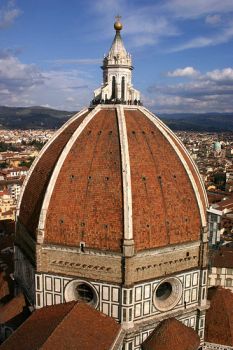 As I said above, Florence is crowded year-round. In the summer months, you have the predictable groups of tourists following flag-wielding tour guides through the highlights of one of the most art-rich cities on earth. The lines for the Uffizi Gallery are unspeakably long, and you may have to wait your turn to get a “front row” spot on the edge of the Ponte Vecchio for an unobstructed view of the Arno River.
As I said above, Florence is crowded year-round. In the summer months, you have the predictable groups of tourists following flag-wielding tour guides through the highlights of one of the most art-rich cities on earth. The lines for the Uffizi Gallery are unspeakably long, and you may have to wait your turn to get a “front row” spot on the edge of the Ponte Vecchio for an unobstructed view of the Arno River.
So, outside the peak tourism season, the city slows down, right? Not so much.
Because of the wall-to-wall art history that is Florence, it’s also a popular stop for school trips throughout the school year. So while those packs of visitors in front of the Duomo or waiting in line to see Michelangelo’s “David” may not be middle-aged Americans, they’re not locals, either. Seeing Florence outside the summer months does have its advantages, however, even if you are bumping into Italian teens everywhere you go – the prices are lower, and the restaurants you’ll want to eat in aren’t likely to be as busy (since the teenagers are eating cheap elsewhere).
Whenever you visit Florence, your itinerary will likely include at least two (if not more) of the city’s art galleries and museums. So before you go, be absolutely sure you find out what days of the week you’ll be in Florence and what days of the week the museums are closed (each one has different closed days). This could prevent the unhappy realization that the only day you have left to see the Uffizi is the one day it’s closed.
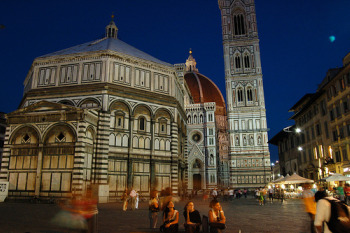 Assuming you’re following my 2-week Italy itinerary and are on your way to Florence from the Cinque Terre, the first thing on your Florence to-do list isn’t even in the city of Florence – it’s a brief stop in Pisa. Because you’ll have to change trains en route anyway, you might as well make it in Pisa where you can stow your bags at the train station for a couple hours and hop on a bus into the city center to see the famous leaning tower of Pisa. You can book tickets in advance if you’d like to climb it, or just take your goofy pictures pretending you’re holding it up, before grabbing some lunch and getting back on the next train to Florence.
Assuming you’re following my 2-week Italy itinerary and are on your way to Florence from the Cinque Terre, the first thing on your Florence to-do list isn’t even in the city of Florence – it’s a brief stop in Pisa. Because you’ll have to change trains en route anyway, you might as well make it in Pisa where you can stow your bags at the train station for a couple hours and hop on a bus into the city center to see the famous leaning tower of Pisa. You can book tickets in advance if you’d like to climb it, or just take your goofy pictures pretending you’re holding it up, before grabbing some lunch and getting back on the next train to Florence.
>> If you’re arriving in Florence from another destination that doesn’t have Pisa right on the way, a day trip to Pisa from Florence is very easy to manage with direct trains and really only requires a half-day.
You’ll arrive in Florence in the early afternoon, then, and settle into your hotel room before going out to explore a little bit before dinner. My hope is that you’re staying in the historic center of Florence, since that’s where you’ll be spending all your time, and it makes everything you want to see and do within walking distance. Your afternoon stroll gives you a great chance to get the lay of the land around your hotel, scope out a place to have dinner, and – if you haven’t booked your tickets to the galleries in advance – an opportunity to swing by the secret ticket window to see what they have available.
I tend to think of the Duomo in Florence as the hub of the historic center, so I find that gravitating toward the Duomo at some point soon after arriving in the city is a nice way to check in. The square in front of the Duomo offers some great people-watching (though it can also be a haven for pickpockets, especially during summer, so keep your valuables close and/or hidden).
Other touchstones for your time in Florence are likely to be the Piazza della Signoria and the Ponte Vecchio, so getting familiar with where they are in relation to your hotel isn’t a bad idea on your first day. And even if you’ve already located one place that looks ideal for dinner that night, keep an eye out for spots to eat later in your stay. Oh, and by all means enjoy your getting-to-know-you stroll through Florence with a scoop or two of gelato.
Depending on how much energy you have (and how many open hours are left at the various sites), you could squeeze in a spin through church or two on this first evening before dinner if you like. Personally, I prefer to leave my first few hours in a new city completely open for walking, but if (for instance) you’re passing through the Piazza del Duomo and are just dying to go inside, by all means – do.
Otherwise, enjoy exploring this beautiful city at whatever pace your feet want to take you.
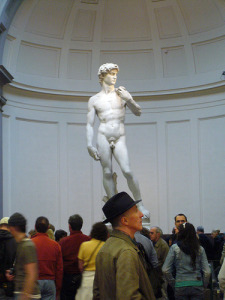 I have dubbed this day “art day,” but again, be sure to check what days the various museums are closed – you may have to shuffle a few things around on your itinerary.
I have dubbed this day “art day,” but again, be sure to check what days the various museums are closed – you may have to shuffle a few things around on your itinerary.
Calling one day “art day” in a city that’s spilling over with art is a little silly, but what I mean is that this is the day you’ll spend in the city’s big three art galleries/museums. If you haven’t booked your Uffizi tickets and Accademia tickets in advance, and you weren’t able to get anything at the secret ticket window mentioned above, you might be forced to wait in long lines to get into these two biggies – which severely cuts down on your time inside each one, let alone the amount of time you have to do other things during the day. In other words, especially during (but not limited to) the high season, advance booking is highly recommended.
For the sake of argument, we’re going to assume you’ve got tickets and aren’t wasting hours in line.
It doesn’t matter which order you do these in, but the three galleries/museums I’d put together in one day are the Uffizi, the Accademia, and the Bargello. The latter is less popular by a long shot, but includes some incredible sculpture by famous artists (including an early Michelangelo), so it’s one I recommend. You’re likely to spend the most time in the Uffizi, and the least in the Accademia (there’s almost nothing inside but the “David”), so you might want to do the Uffizi first thing, then have lunch, and then tackle the other two after you eat. Don’t go into any of these places on an empty stomach.
After a full day of art galleries, reward yourself with another couple scoops of gelato and a leisurely walk around a neighborhood you find particularly enjoyable. I like the Oltrarno, which is what they call the area across the river from the Uffizi (Oltrarno meaning “other Arno,” or the other side of the Arno River), and it tends to be a little less crowded than the Duomo side of the river. If you’re up for it and the weather’s good, a hike up the hill to the Piazzale Michelangelo is a lovely place to watch the sun set over the city. Otherwise, there’s a bus that’ll take you up to the top of the hill, too (you can always walk back down!).
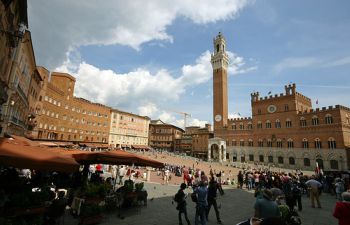 That heading is a misnomer, because this day is the one where you’ll hop on a bus in the morning and take a day-trip to Siena.
That heading is a misnomer, because this day is the one where you’ll hop on a bus in the morning and take a day-trip to Siena.
Getting from Florence to Siena is easy, as there are regular buses (there are also trains, but the bus is the better option), and since it’s around 1.5 hours one-way it’s an excellent day-trip destination. It’s regularly cited as a favorite stop in Tuscany, and with good reason. It’s also a popular day-trip, so while staying overnight will allow you to see the city when it’s less crowded, a day-trip to Siena is better than no trip to Siena.
Much of what’s enjoyable about a visit to Siena is just walking through the beautiful meandering lanes of the old walled city, but the don’t-miss sights include the Duomo, the Baptistery, the main square (called the Campo), and the City Hall (where you can climb the tower over the Campo for great views over the red rooves). Siena’s patron saint, Saint Catherine, is also – at least partially – on display in the Basilica di San Domenico (they have her head and one finger), so that’s worth a stop if you’re into relics.
Before you leave the Siena bus station to explore the city, find out what the return bus schedule is like – then you’re better equipped later on to decide whether you want to have dinner in Siena and take a late bus back or take an earlier bus back and have dinner again in Florence. Also, if you end up not spending a full day in Siena, you might be able to check off a couple churches in Florence before dinner if you like – or just enjoy some more people-watching in Florence’s other prime spot for that activity, the Piazza della Signoria.
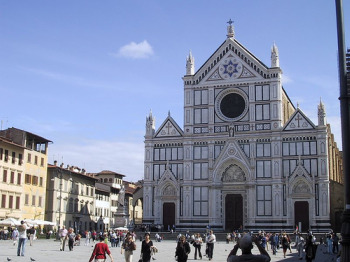 If day two was “art day,” then day four is “church day.”
If day two was “art day,” then day four is “church day.”
As is the case with many cities in Italy, the churches in Florence are worthwhile attractions not just for their religious or historic significance, but also often because they have stunning artwork on display inside. Such is the case with many churches in Florence – and while you would need a longer visit to see them all, you can certainly get a good sample in a day.
Because there are so many options when it comes to churches in Florence, I highly recommend you read up on the various churches to see which ones you’d like to visit during “church day” so you don’t inadvertently skip the one that has art by a favorite painter. Some of your options include:
Another thing to do on this day, if you haven’t done it already, is to wander through the Florence leather market. If you’re really in the market for some leather goods, you’d be smart to start looking earlier in your stay so you know what the prices are and can begin to formulate your haggling plan. If you’re just looking, it’s still a fun diversion (and it’s a small market, so it’s a quick stop). Just keep an eye on your purses and wallets, as the markets are also notorious for pickpockets.
You can also use your last day in Florence to check off any of the things from earlier in the itinerary that you wanted to do but couldn’t fit in that day. Maybe the Accademia was closed on “art day,” for instance, or it was raining earlier in your trip so you couldn’t get a good view over the city from the Piazzale Michelangelo. And by all means, if you haven’t had your requisite two scoops of gelato per day during your whole stay in Florence, make up for lost time before you leave.
>> There are, obviously, lots of things to do in Florence that I’ve left out of this itinerary – the Palazzo Vecchio, the Pitti Palace, the Boboli Gardens, and more. Feel free to swap some of my suggestions out for one of these – or anything else in Florence – if it appeals to you more. And if you still can’t squeeze it all in, then start planning your return trip before you even leave!
If you’re following along with my recommended route through Italy, then you’ll be getting on a morning train the next day to spend five days in Rome, dreams of Michelangelo and gelato still dancing in your head. Read more about how to get from Florence to Rome. My recommendation is to take the train, and you’ll get Trenitalia’s best fares if you book in advance using the box below.
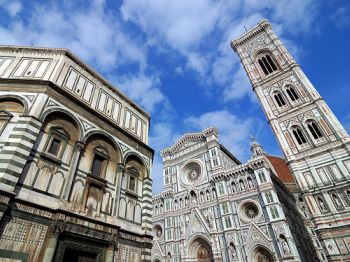 No matter how long you’re planning to be in Florence, here are some more articles you might find handy:
No matter how long you’re planning to be in Florence, here are some more articles you might find handy:
photos, top to bottom, by: Alaskan Dude, ralphunden, James & Vilija, lesteph, Matthias Rosenkranz, Rosino